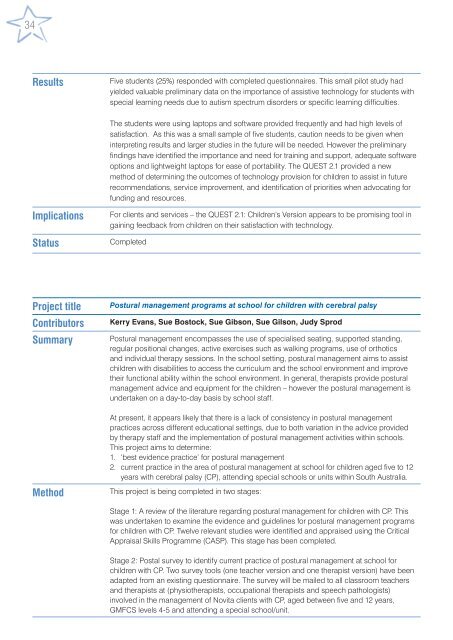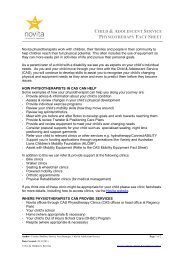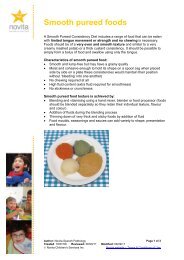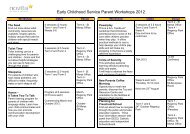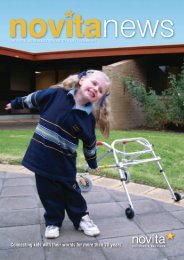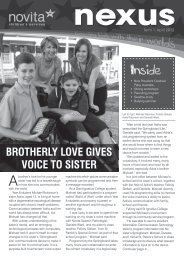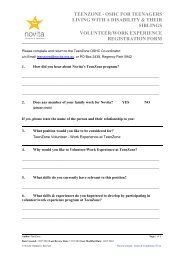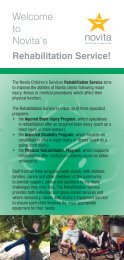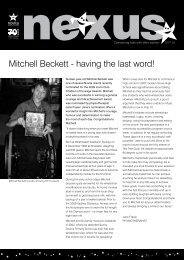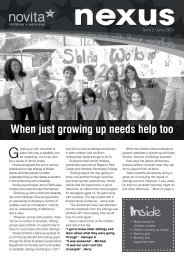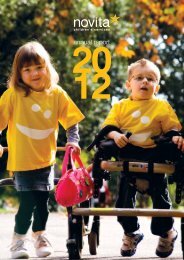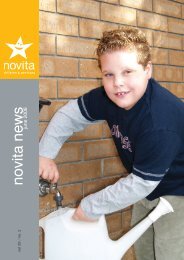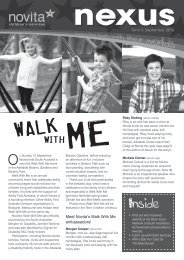Novita Research Report - 2004 to 2007 - Novita Children's Services
Novita Research Report - 2004 to 2007 - Novita Children's Services
Novita Research Report - 2004 to 2007 - Novita Children's Services
- No tags were found...
You also want an ePaper? Increase the reach of your titles
YUMPU automatically turns print PDFs into web optimized ePapers that Google loves.
34ResultsFive students (25%) responded with completed questionnaires. This small pilot study hadyielded valuable preliminary data on the importance of assistive technology for students withspecial learning needs due <strong>to</strong> autism spectrum disorders or specific learning difficulties.The students were using lap<strong>to</strong>ps and software provided frequently and had high levels ofsatisfaction. As this was a small sample of five students, caution needs <strong>to</strong> be given wheninterpreting results and larger studies in the future will be needed. However the preliminaryfindings have identified the importance and need for training and support, adequate softwareoptions and lightweight lap<strong>to</strong>ps for ease of portability. The QUEST 2.1 provided a newmethod of determining the outcomes of technology provision for children <strong>to</strong> assist in futurerecommendations, service improvement, and identification of priorities when advocating forfunding and resources.ImplicationsStatusFor clients and services – the QUEST 2.1: Children’s Version appears <strong>to</strong> be promising <strong>to</strong>ol ingaining feedback from children on their satisfaction with technology.CompletedProject titleContribu<strong>to</strong>rsSummaryMethodPostural management programs at school for children with cerebral palsyKerry Evans, Sue Bos<strong>to</strong>ck, Sue Gibson, Sue Gilson, Judy SprodPostural management encompasses the use of specialised seating, supported standing,regular positional changes, active exercises such as walking programs, use of orthoticsand individual therapy sessions. In the school setting, postural management aims <strong>to</strong> assistchildren with disabilities <strong>to</strong> access the curriculum and the school environment and improvetheir functional ability within the school environment. In general, therapists provide posturalmanagement advice and equipment for the children – however the postural management isundertaken on a day-<strong>to</strong>-day basis by school staff.At present, it appears likely that there is a lack of consistency in postural managementpractices across different educational settings, due <strong>to</strong> both variation in the advice providedby therapy staff and the implementation of postural management activities within schools.This project aims <strong>to</strong> determine:1. ‘best evidence practice’ for postural management2. current practice in the area of postural management at school for children aged five <strong>to</strong> 12years with cerebral palsy (CP), attending special schools or units within South Australia.This project is being completed in two stages:Stage 1: A review of the literature regarding postural management for children with CP. Thiswas undertaken <strong>to</strong> examine the evidence and guidelines for postural management programsfor children with CP. Twelve relevant studies were identified and appraised using the CriticalAppraisal Skills Programme (CASP). This stage has been completed.Stage 2: Postal survey <strong>to</strong> identify current practice of postural management at school forchildren with CP. Two survey <strong>to</strong>ols (one teacher version and one therapist version) have beenadapted from an existing questionnaire. The survey will be mailed <strong>to</strong> all classroom teachersand therapists at (physiotherapists, occupational therapists and speech pathologists)involved in the management of <strong>Novita</strong> clients with CP, aged between five and 12 years,GMFCS levels 4-5 and attending a special school/unit.


